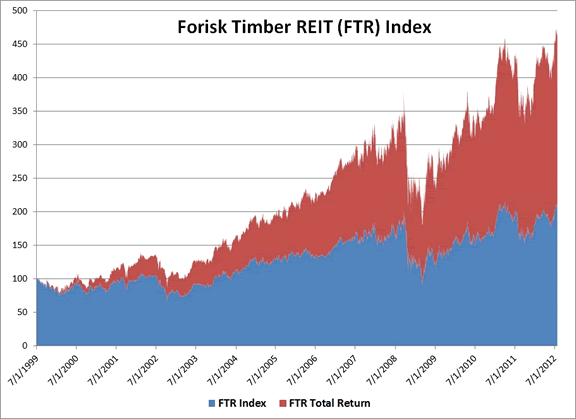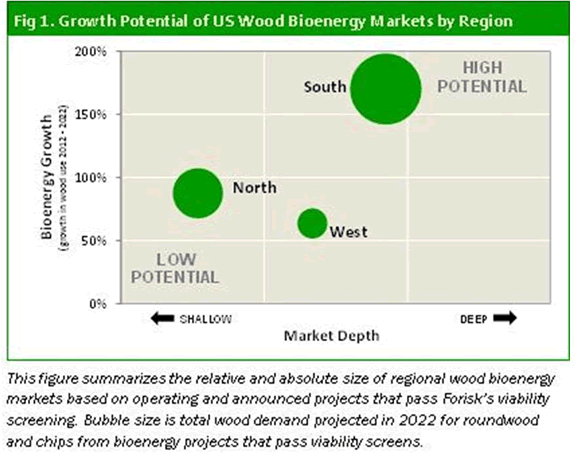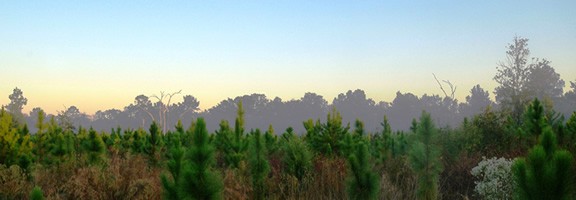Investments in wood bioenergy projects and timberland-owning firms follow different paths. Overall, the wood bioenergy sector continues to sift the weak from the somewhat viable. As of June 25 2012, Wood Bioenergy US counts 454 announced and operating wood bioenergy projects in the US. Based on Forisk analysis, 297 projects pass basic viability screening. In short, one-third of the known projects fail basic litmus tests.
Alternately, timber REITs are spinning cash. Rayonier’s (RYN) recently announced ten percent dividend increase reminded me of the well-traveled quote from investor and Dallas Mavericks owner Mark Cuban on stocks and dividends:
I believe non dividend stocks aren’t much more than baseball cards. They are worth what you can convince someone to pay for it.
The quote speaks to the importance of considering ‘total return’, which accounts for both (cash) income and (capital) appreciation, when valuing investments. For timberland-owning REITs, this includes (1) quarterly dividends and (2) changes in stock prices for a given time frame. For direct timberland investments, this includes (1) income generated from, in part, timber sales and other forest management activities as well as (2) appreciation of the land and standing forest.
Timber REITs and Dividend Yields
Publicly-traded timber REITs, as measured by the Forisk Timber REIT (FTR) Index, generated 2012 total returns – through July 27 – of 19.93%. On that day, the four timber REITs provided the following dividend yields:
- Plum Creek (PCL): 4.15%
- Potlatch (PCH): 3.69%
- Rayonier (RYN): 3.50%
- Weyerhaeuser (WY): 2.54%
However, timberland investments remain distinct from those in timber REITs; it’s not an acorn-to-acorn comparison. For multi-year investors, direct ownership of timberlands continue to provide superior capital preservation and diversification, while public REITs offer superior liquidity and total returns with more risk. While timber REITs attract attention from dividend-seeking investors, the figure below highlights the advantages and disadvantages of focusing solely on dividend yields (income) when investing in equities. Equity values can and will dive with the overall market (see 2008-2009) while long-term investors gained through buy-and-hold-and-dividend reinvestment strategies.

Wood Bioenergy: Location, Location, Location…
The current issue of Wood Bioenergy US focuses on two aspects of regional wood bioenergy markets. First, it reviews the potential demand for pulpwood and chips by region in the US to address the question “where does wood bioenergy most directly affect timberland investors and forest industry procurement managers at pulp mills and OSB plants?” Second, it evaluates the ability of regional markets to absorb and support new wood bioenergy projects by prioritizing regions with large, established, high-volume pulpwood markets, suppliers and the related infrastructure. The results show how “market depth” helps explain why new wood bioenergy investment and projects migrate to different parts of the United States, especially the US South.

Locations and Total Return
Regardless the policy mandates and investor interests, regional analysis of US bioenergy markets highlights how specific geographies provide superior access to raw material and infrastructure resources for supporting high growth investment opportunities. The costs associated with locating and building wood bioenergy projects can exceed those to build and operate (in terms of dollars per unit of electricity output) natural gas or coal plants. As such, factors determining the success and failure of projects matter. And these factors differ by geographic region and technology type. For timberland investors, geography dictates soil quality and market strength, while financial performance depends on total return over time.
This content may not be used or reproduced in any manner whatsoever, in part or in whole, without written permission of LANDTHINK. Use of this content without permission is a violation of federal copyright law. The articles, posts, comments, opinions and information provided by LANDTHINK are for informational and research purposes only and DOES NOT substitute or coincide with the advice of an attorney, accountant, real estate broker or any other licensed real estate professional. LANDTHINK strongly advises visitors and readers to seek their own professional guidance and advice related to buying, investing in or selling real estate.










Add Comment